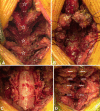Minimum 2-year outcome of cervical laminoplasty with deep extensor muscle-preserving approach: impact on cervical spine function and quality of life
- PMID: 19214599
- PMCID: PMC3234000
- DOI: 10.1007/s00586-009-0892-1
Minimum 2-year outcome of cervical laminoplasty with deep extensor muscle-preserving approach: impact on cervical spine function and quality of life
Abstract
In this retrospective cohort study, two surgical methods of conventional open-door laminoplasty and deep extensor muscle-preserving laminoplasty were allocated for the treatment of cervical myelopathy, and were specifically compared in terms of axial pain, cervical spine function, and quality of life (QOL) with a minimum follow-up period of 2 years. Eighty-four patients were divided into two groups and received either a conventional open-door laminoplasty (CL group) or laminoplasty using a deep extensor muscle-preserving approach (MP group). The latter approach was performed by preserving multifidus and semispinalis cervicis attachments followed by open-door laminoplasty and re-suture of the bisected spinous processes at each decompression level. The average follow-up period was 38 months (25-53 months). The preoperative and follow-up evaluations included the original Japanese Orthopaedic Association (JOA) score, the new tentative JOA score including cervical spine function and QOL, and the visual analogue scale (VAS) of axial pain. Radiological analyses included cervical lordosis and flexion-extension range of motion (flex-ext ROM) (C2-7), and deep extensor muscle areas on MR axial images. The JOA recovery rates were statistically equivalent between two groups. The MP group demonstrated a statistically superior cervical spine function (84% vs 63%) and QOL (61% vs 45%) when compared to the CL group at final follow-up (P < 0.05). The average VAS scores at final follow-up were 2.3 and 4.9 in MP and CL groups (P < 0.05). The cervical lordosis and flex-ext ROM were statistically equivalent. The percent deep muscle area on MRI demonstrated a significant atrophy in CL group compared to that in MP group (56% vs 88%; P < 0.01). Laminoplasty employing the deep extensor muscle-preserving approach appeared to be effective in reducing the axial pain and deep muscle atrophy as well as improving cervical spine function and QOL when compared to conventional open-door laminoplasty.
Figures




Similar articles
-
Impact of deep extensor muscle-preserving approach on clinical outcome of laminoplasty for cervical spondylotic myelopathy: comparative cohort study.Eur Spine J. 2012 Aug;21(8):1536-44. doi: 10.1007/s00586-012-2260-9. Epub 2012 Mar 23. Eur Spine J. 2012. PMID: 22441562 Free PMC article. Clinical Trial.
-
Results of skip laminectomy-minimum 2-year follow-up study compared with open-door laminoplasty.Spine (Phila Pa 1976). 2003 Dec 15;28(24):2667-72. doi: 10.1097/01.BRS.0000103340.78418.B2. Spine (Phila Pa 1976). 2003. PMID: 14673367
-
C3 laminectomy combined with modified unilateral laminoplasty and in situ reconstruction of the midline structures maintained cervical sagittal balance: a retrospective matched-pair case-control study.Spine J. 2020 Sep;20(9):1403-1412. doi: 10.1016/j.spinee.2020.04.023. Epub 2020 May 6. Spine J. 2020. PMID: 32387294
-
Modified Laminoplasty Preserving the Posterior Deep Extensor Insertion into C2 Improves Clinical and Radiologic Results Compared with Conventional Laminoplasty: A Meta-Analysis.World Neurosurg. 2018 Mar;111:157-165. doi: 10.1016/j.wneu.2017.12.098. Epub 2017 Dec 23. World Neurosurg. 2018. PMID: 29277594 Review.
-
Cervical alignment and range of motion after laminoplasty: radiographical data from more than 500 cases with cervical spondylotic myelopathy and a review of the literature.Spine (Phila Pa 1976). 2012 Sep 15;37(20):E1243-50. doi: 10.1097/BRS.0b013e3182659d3e. Spine (Phila Pa 1976). 2012. PMID: 22739671 Review.
Cited by
-
Impact of different laminae open angles on axial symptoms after expansive open-door laminoplasty.Medicine (Baltimore). 2018 Aug;97(32):e11823. doi: 10.1097/MD.0000000000011823. Medicine (Baltimore). 2018. PMID: 30095657 Free PMC article.
-
<Editors' Choice> Neck pain after cervical laminoplasty is associated with postoperative atrophy of the trapezius muscle.Nagoya J Med Sci. 2023 Feb;85(1):103-112. doi: 10.18999/nagjms.85.1.103. Nagoya J Med Sci. 2023. PMID: 36923613 Free PMC article.
-
Open-door cervical laminoplasty with preservation of posterior structures.Global Spine J. 2012 Mar;2(1):15-20. doi: 10.1055/s-0032-1307258. Global Spine J. 2012. PMID: 24353941 Free PMC article.
-
Risk factors of axial symptoms after posterior cervical spine surgery: a meta-analysis.BMC Surg. 2025 Aug 21;25(1):380. doi: 10.1186/s12893-025-03074-6. BMC Surg. 2025. PMID: 40841893 Free PMC article.
-
Long-term results of double-door laminoplasty using hydroxyapatite spacers in patients with compressive cervical myelopathy.Eur Spine J. 2011 Sep;20(9):1560-6. doi: 10.1007/s00586-011-1724-7. Epub 2011 Feb 19. Eur Spine J. 2011. PMID: 21336508 Free PMC article.
References
-
- Hirabayashi K, Toyama Y. Choice of surgical procedure for cervical ossification of the posterior longitudinal ligaments. In: Yonenobu K, Sakou T, Ono K, editors. ossification of the posterior longitudinal ligament. Tokyo: Springer; 1997. pp. 135–142.
Publication types
MeSH terms
LinkOut - more resources
Full Text Sources
Medical
Miscellaneous

